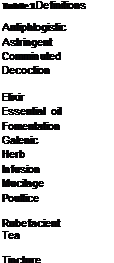Botanicals must undergo a significant amount of processing prior to incorporation into a cosmeceutical which usually significantly affects the biologic activity of the herb. The most important factor for biologic activity is the source of the plant material because each plant part may contain hundreds of different chemicals, ions and molecules. Growing conditions including soil composition, amount of available water, climate variations, plant stress, and harvesting conditions such as time from harvest to transport, care of plant materials during shipping, storage conditions prior to manufacture, and preparation of the herb and final product as well as mixing with other herbs are other factors that may substantially alter solubility, stability, biologic availability, pharmacokinetics, pharmacologic activity, and toxicity.
Galenic extracts are made from leaves, roots, fruits, berries, stems, twigs, barks, and flowers by crushing, grinding, comminuting, boiling, distilling, pressing, drying, or exposing to solvents. Usually, the plant material is heated or processed to obtain essential oils or other distillates that can be easily added to a cosmetic formulation; however, this processing may destroy or adversely modify some of the physiologically active molecules. The results are oil, wax, juice, tincture, decoction, tea, infusion, and/or powders which are then formulated into topical applications including solutions, gels, lotions, creams, ointments, and pastes. Some of these preparations are further applied as fomentation, compress, or poultice (2,8). These terms are defined in Table 1 (9).
The concentration of the herb, its extract, and the active molecules affect therapeutic activity. Usually in cosmeceuticals the medicinal botanicals are added in very small, subtherapeutic amounts for the marketing story. Most synthetic pharmaceuticals, utilize a very low concentration to provide the desired effect. Few herbs are that potent, thus higher doses (>1%) are needed. Herbal efficacy is challenged by the trans-stratum corneum delivery of mucocutaneous surfaces which is usually difficult due to the
Preventing and/or relieving inflammation Arrests secretions, contracts tissue, and controls bleeding Whole plant or portion broken into multiple pieces Liquid extract produced by simmering the plant part in water for over 20 minutes
 Sweetened alcohol extract
Sweetened alcohol extract
Concentrated oil from the whole plant, usually volatile, and fragrant Liquid extract soaked cloth Crude plant remedies
Botanical used for medicine, flavoring, or fragrance Liquid extracts combined in hot water
Botanicals that swell with exposure to water for soothing application Liquid extract combined with powdered herb applied directly to lesions while mass is moist
Substance that causes cutaneous erythema by counter-irritant effects Dried whole or parts of plant simmered in hot water usually 5-10 minutes
Alcoholic solution of whole or portion of plant or extract herb’s concentration and multiple active compounds with different solubility, polarity, and therapeutic concentration as well as reactivity of different mucocutaneous receptors.
These complex biologic science and formulation issues indicate the only validation of herbal activity in a cosmeceutical formulation is a human clinical trial conducted by a reputable third-party researcher. Without such studies, health care providers and the public are being asked to trust in products based on voodoo science.
